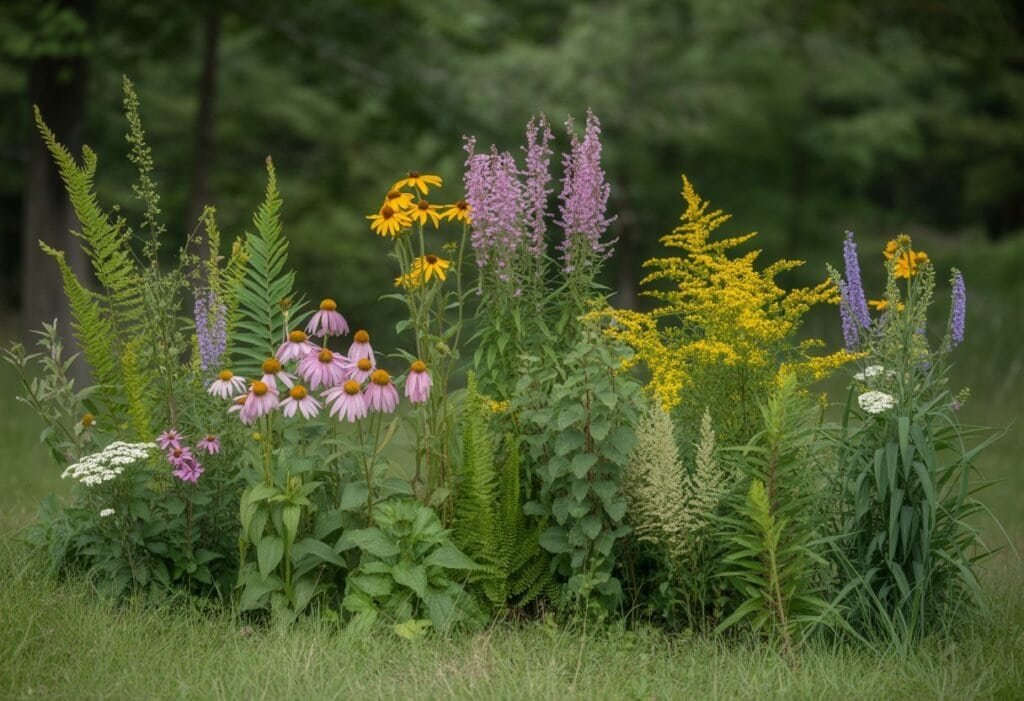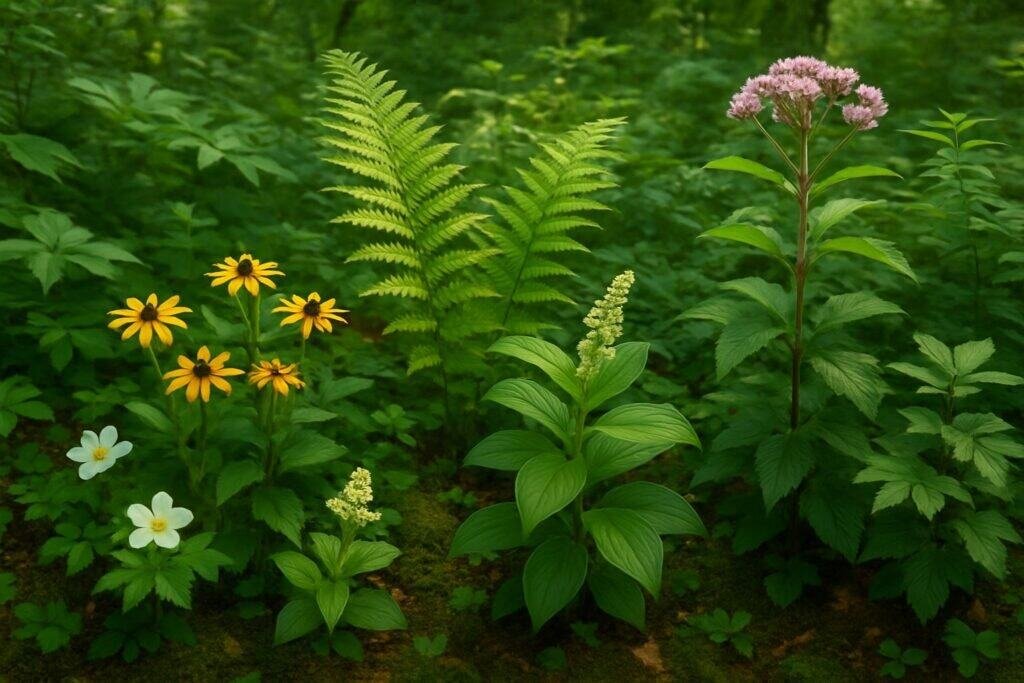Native plants are a treasure for Cincinnati gardeners and nature lovers. These plants have evolved in our local climate over thousands of years.
They are perfectly suited for our soil and weather conditions. Growing native plants in Cincinnati gardens helps support local wildlife.
Native plants reduce maintenance needs and create beautiful landscapes. They connect us to our region’s natural heritage.
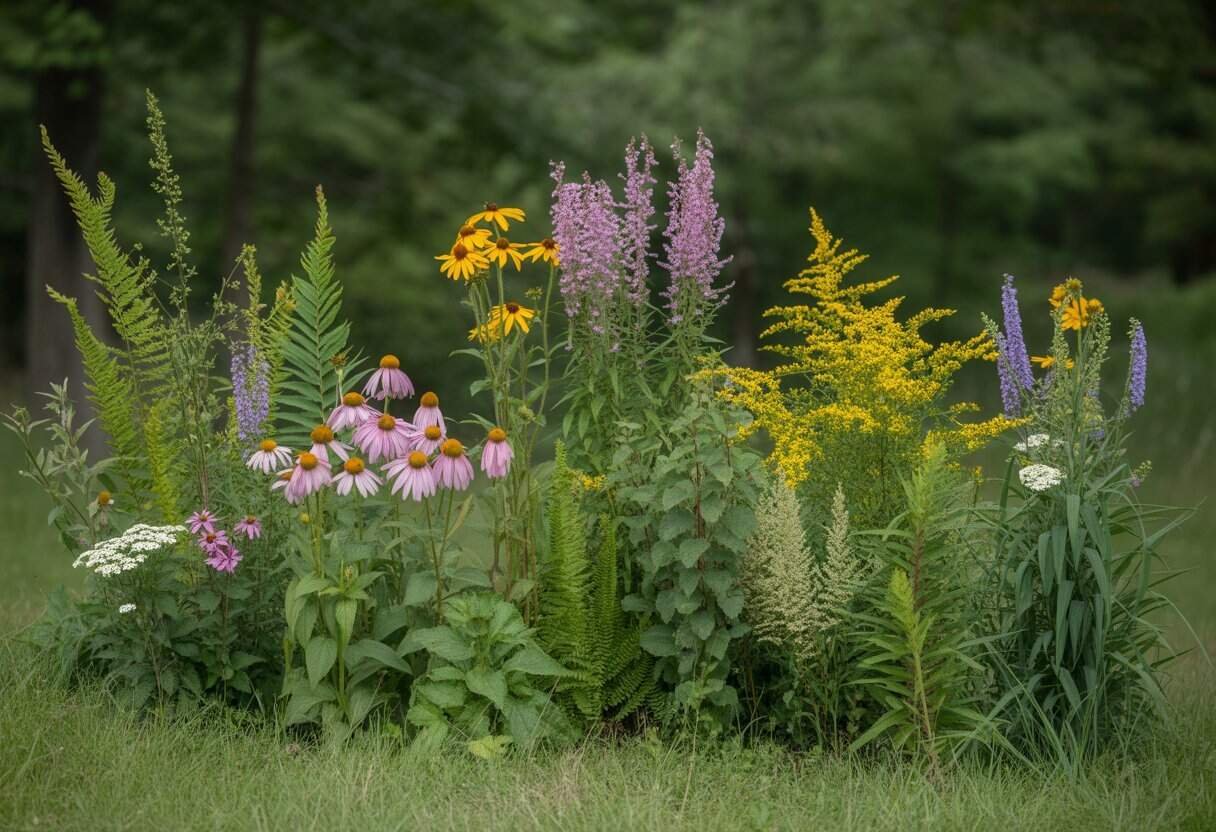
Our area sits at a unique ecological crossroads where northern and southern plant communities meet. This gives Cincinnati gardeners access to an impressive variety of native options.
You can choose prairie grasses like Little Bluestem or woodland flowers such as Virginia Bluebells. Many native plants thrive in our clay-heavy soils.
They can withstand both summer heat and winter cold. The growing movement toward native landscaping in Cincinnati reflects a deeper understanding of ecological health.
By choosing plants that belong here, we create habitats for pollinators. We also reduce water usage and limit the spread of invasive species.
Key Takeaways
- Native plants in Cincinnati require less maintenance while providing essential habitat for local wildlife.
- Cincinnati’s unique position between ecological regions offers gardeners a diverse selection of native plant options.
- Incorporating native species helps combat invasive plants and preserves the natural character of our local ecosystem.
What Are Native Plants in Cincinnati?
Native plants in Cincinnati are species that have evolved naturally in this region over thousands of years. They have adapted perfectly to local soil conditions, rainfall patterns, and seasonal changes.
These plants form the foundation of healthy local ecosystems and provide essential habitat for wildlife.
Defining Native Flora
Native flora in Cincinnati includes plants that existed in the region before European settlement. These plants evolved alongside local wildlife, creating balanced ecological relationships.
Native plants in this area adapted to Cincinnati’s specific climate, including hot summers, cold winters, and moderate rainfall. Native species have deep root systems that help prevent erosion and filter water naturally.
They require less maintenance, fertilizer, and water once established. This makes them environmentally friendly and cost-effective for gardeners.
Ohio’s native plants have co-evolved with local pollinators. They provide essential food sources at the right times of year.
This synchronization helps maintain healthy populations of bees, butterflies, and other beneficial insects.
Significance to Ohio’s Ecosystem
Native plants serve as the backbone of Cincinnati’s natural environment. They provide food, shelter, and breeding grounds for local wildlife.
Without these plants, many animal species would struggle to survive. The deep root systems of native plants help manage stormwater, reducing flooding and erosion.
This natural infrastructure is important as Cincinnati experiences more extreme weather. Native plants also play a crucial role in improving soil health.
They add organic matter and support beneficial soil microorganisms. Many native species restore soil nutrients rather than depleting them.
Ohio’s biodiversity depends on these plants. They create complex habitat layers from ground covers to canopy trees.
Notable Native Species in the Region
Cincinnati’s landscape features many beautiful native plants worth incorporating into gardens.
Trees and Shrubs:
- Ohio Buckeye (Aesculus glabra)
- Eastern Redbud (Cercis canadensis)
- Flowering Dogwood (Cornus florida)
- Serviceberry (Amelanchier arborea)
Wildflowers:
- Purple Coneflower (Echinacea purpurea)
- Wild Columbine (Aquilegia canadensis)
- Black-eyed Susan (Rudbeckia hirta)
- Cardinal Flower (Lobelia cardinalis)
Native grasses like Little Bluestem (Schizachyrium scoparium) and Prairie Dropseed (Sporobolus heterolepis) provide winter interest and habitat. These plants support monarch butterflies, native bees, and songbirds.
Cincinnati’s oak trees support over 500 species of caterpillars. These caterpillars become food for birds and other wildlife.
Benefits of Growing Native Plants
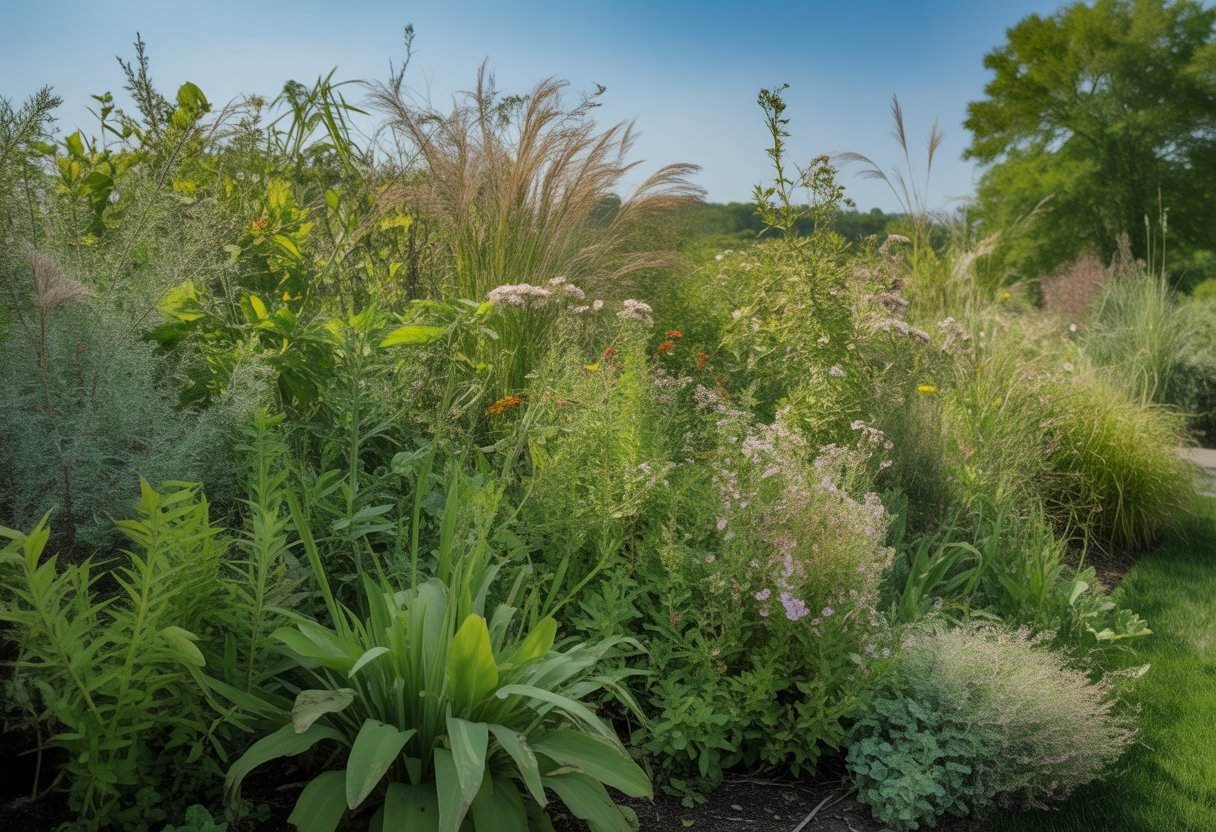
Native plants in Cincinnati offer many advantages for gardeners and the environment. These plants have evolved in our local conditions.
They provide essential support for wildlife while requiring less maintenance than non-native species.
Supporting Local Wildlife
Native plants create important habitats for local wildlife species. Cincinnati’s native oak trees support over 500 species of caterpillars.
These caterpillars become food for birds and other animals. Native plants produce seeds, nuts, fruits, and nectar that match the nutritional needs of local wildlife.
Birds like cardinals, chickadees, and woodpeckers rely on native plants for food and shelter. They build nests in native shrubs and trees.
Native plants also provide shelter during harsh weather. Many animals use fallen leaves and dense vegetation as protection.
In Cincinnati, plants like coneflowers, asters, and milkweed create a complete ecosystem in your yard.
Creating a Pollinator Habitat
Native plants form the foundation of healthy pollinator habitats in Cincinnati gardens. Pollinators like bees, butterflies, and moths have co-evolved with these plants.
Milkweed species are essential for monarch butterflies. They provide the only food source for monarch caterpillars.
Native asters and goldenrods bloom late in the season, offering crucial nectar when other food sources are scarce. Different pollinators need different flower shapes.
Native plants offer:
- Tubular flowers for hummingbirds
- Flat landing pads for butterflies
- Clustered blooms for bees
Create a succession of blooms with spring beauties, summer coneflowers, and fall asters. This ensures pollinators have food throughout the growing season.
Even a small native plant garden can support many pollinator species.
Lower Maintenance Requirements
Native plants reduce the time and resources needed for garden maintenance. Once established, they rarely need supplemental watering.
These plants have developed natural defenses against local pests and diseases. You don’t need pesticides or chemical treatments.
Their deep root systems help them access nutrients deep in the soil, reducing or eliminating fertilizer needs. Native plants like prairie dropseed and little bluestem are drought-tolerant alternatives to traditional lawns.
They don’t need weekly mowing or constant watering during summer heat. Many Cincinnati natives are perennials that return year after year.
This saves both money and time as the plants mature.
Promoting Biodiversity
Native plants are key to maintaining healthy biodiversity in Cincinnati’s ecosystem. They create interconnected food webs where diverse species support one another.
A single native oak can host hundreds of insect species that feed birds and other wildlife. Biodiversity provides natural resilience against environmental challenges.
When gardens include varied native plants, they can better withstand droughts, floods, and pest outbreaks. Different species thrive in different conditions.
By planting:
- Wet areas: Cardinal flower, blue lobelia
- Dry spots: Butterfly weed, little bluestem
- Shade: Wild ginger, woodland phlox
- Sun: Prairie coneflower, blazing star
Native plant diversity helps maintain healthy soil biology. Their varied root structures improve soil quality.
They support beneficial fungi and microorganisms essential for plant health.
Choosing the Right Native Plants for Your Cincinnati Garden
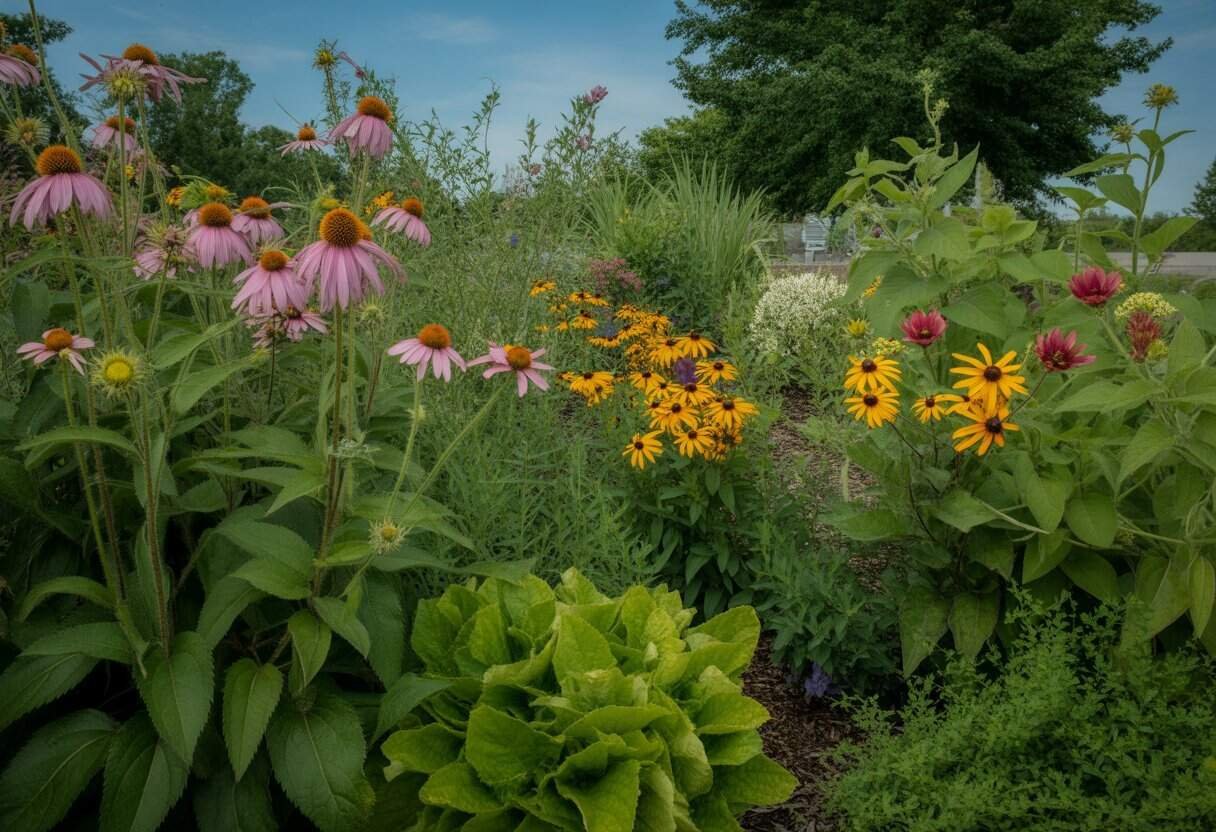
Native plants in Cincinnati offer many benefits for your garden. They require less maintenance and support local wildlife.
These plants thrive in our specific climate conditions without extra work.
Understanding Local Soil and Climate
Cincinnati has clay-heavy soil that can be challenging for many plants. This clay retains water but can become compacted easily.
Most native plants have adapted to these conditions over thousands of years. Cincinnati falls in USDA hardiness zones 6a and 6b, with cold winters and hot, humid summers.
Annual rainfall averages about 42 inches throughout the year. Before planting, test your soil pH.
Most Cincinnati soils are slightly acidic to neutral (pH 6.0-7.0). Some areas may have alkaline soil due to limestone bedrock.
Consider your yard’s microclimate too. Urban areas tend to be warmer than rural settings.
Low areas may collect more moisture, while hillsides drain quickly.
Best Native Plants for Sun and Shade
Full Sun Plants:
- Purple Coneflower (Echinacea purpurea) – Drought-tolerant with summer-long blooms
- Black-Eyed Susan (Rudbeckia fulgida) – Bright yellow flowers from July to October
- Prairie Dropseed (Sporobolus heterolepis) – Attractive grass with airy seed heads
Part Sun/Part Shade:
- Wild Blue Phlox (Phlox divaricata) – Spring-blooming groundcover with blue flowers
- Ohio Spiderwort (Tradescantia ohiensis) – Blue-purple flowers that open in morning
Full Shade Plants:
- Wild Ginger (Asarum canadense) – Excellent groundcover for woodland gardens
- Christmas Fern (Polystichum acrostichoides) – Evergreen fern for difficult shady spots
Match plants to your garden’s light conditions for best results. Most native plant tags indicate light preferences.
Plants That Attract Pollinators
Pollinators face habitat loss in Cincinnati. Native plants provide essential food and shelter for bees, butterflies, and other beneficial insects.
For Butterflies:
- Milkweed (Asclepias species) – Essential for Monarch butterflies
- Joe-Pye Weed (Eutrochium purpureum) – Attracts swallowtails and many others
- New England Aster (Symphyotrichum novae-angliae) – Critical late-season nectar source
For Bees:
- Wild Bergamot (Monarda fistulosa) – Attracts numerous bee species
- Golden Alexanders (Zizia aurea) – Early spring bloomer for early-season bees
Plant in groups of three or more of the same species. This makes it easier for pollinators to find and collect nectar.
Consider bloom times when selecting plants. Provide continuous food sources from spring through fall.
Landscaping with Native Plants
Native plants bring authentic beauty to Cincinnati gardens. They support local ecosystems and require less maintenance.
These plants create harmonious outdoor spaces that connect with the natural environment.
Design Principles for Native Plants Gardens
When designing with native plants, consider your yard’s conditions first. Cincinnati’s clay soils and varying light patterns affect which plants will thrive in different areas.
Group plants with similar water and sunlight needs together. This practice, called “right plant, right place,” ensures better survival and less maintenance.
Create visual interest by combining plants of different heights:
- Tall background plants: Joe-Pye weed, elderberry
- Medium-height plants: Purple coneflower, butterfly weed
- Ground covers: Wild ginger, woodland phlox
Plant in clusters of odd numbers (3, 5, or 7) rather than single specimens. This creates a more natural appearance and better supports pollinators.
Consider seasonal interest by selecting plants that bloom at different times. Spring beauties and trillium offer early color, while asters and goldenrod extend the show into fall.
Incorporating Native Plants in Rain Gardens
Rain gardens manage stormwater runoff and support biodiversity. In Cincinnati’s climate, they help filter pollutants before reaching waterways.
Choose a rain garden location at least 10 feet from your home’s foundation. Look for a natural low spot where water collects.
Dig a shallow depression 4-8 inches deep with gently sloping sides. This shape encourages water absorption and plant growth.
Effective rain garden plants for Cincinnati include:
- Deep-rooted species like swamp milkweed and fox sedge
- Moisture-loving flowers such as blue flag iris and cardinal flower
- Adaptable shrubs like buttonbush and winterberry
Layer plants based on moisture tolerance. Place water-loving species in the center and drought-tolerant natives around the edges.
A well-designed rain garden drains within 24 hours. This prevents mosquito breeding and helps roots access moisture during dry spells.
Managing Invasive Species in Cincinnati
Invasive plants threaten Cincinnati’s native ecosystems. They crowd out local species and disrupt natural habitats.
These non-native intruders alter soil chemistry, reduce biodiversity, and damage infrastructure if left unchecked.
Identifying Harmful Invasive Plants
Several invasive plants in Cincinnati need immediate attention. White mulberry (Morus alba) has glossy leaves with uneven teeth and white to purple fruits.
It spreads quickly through bird-dispersed seeds. Oriental bittersweet features round, bright orange berries and yellow capsules in fall.
Look for its climbing vines that strangle trees. Callery pear trees have white spring flowers with an unpleasant smell, glossy leaves, and small brown fruits.
They form dense thickets in open areas. Norway maple has broad leaves with pointed lobes and milky sap that oozes when leaves break.
These trees create dense shade that blocks native plant growth. Common privet has oval, opposite leaves and produces black berries.
It forms dense hedges that crowd out native understory plants.
Challenges Posed by White Mulberry and Oriental Bittersweet
White mulberry grows faster than native red mulberry and hybridizes with it. This threatens the genetic purity of native mulberry species.
Oriental bittersweet vines can reach 60 feet in length. They wrap around trees, blocking sunlight and often killing host trees by strangulation or making them top-heavy and prone to storm damage.
Both species reproduce abundantly. A single white mulberry can produce thousands of seeds spread by birds, while oriental bittersweet creates dense seed banks that last for years.
These invasives create monocultures by altering soil chemistry and shading out native seedlings. This reduces habitat quality for wildlife that needs native plant diversity.
Removal and Control Strategies
For small infestations, pull young plants by hand when the soil is moist. Remove the entire root system to prevent regrowth.
For larger trees like Norway maple and Callery pear, hire professionals to cut them and apply targeted herbicide to the cut stumps. This prevents regrowth.
Monitor cleared areas regularly for new seedlings, especially after birds feed on berries. Replace removed invasives with native alternatives.
Plant red mulberry instead of white mulberry. Use American bittersweet or Virginia creeper instead of oriental bittersweet.
Join local volunteer removal days organized by Cincinnati Parks or the Hamilton County Soil and Water Conservation District. These groups offer training on identification and removal techniques.
For large infestations, combine cutting, herbicide treatment, and replanting with natives over several years for best results.
Resources for Native Plant Gardening in Cincinnati
Cincinnati offers several valuable resources for gardeners using native plants. These organizations provide education, plants, and support for successful native gardens throughout the region.
Hamilton County Conservation District
The Hamilton County Conservation District supports native plant enthusiasts in Cincinnati. They host an annual native plant sale each spring, offering locally-grown native species at reasonable prices.
The district offers free soil testing to help gardeners understand their soil conditions. Their website lists native plants suitable for Cincinnati, including recommendations for different light and moisture levels.
They provide free consultations for property owners interested in native landscaping. Throughout the year, they offer workshops on rain gardens, pollinators, and invasive species management.
Their staff includes soil and conservation experts who answer questions about establishing native plant gardens in Cincinnati.
Cincinnati Zoo & Botanical Garden Initiatives
The Cincinnati Zoo & Botanical Garden features native plant displays and demonstration gardens. Their Plant for Pollinators program encourages residents to create habitats for bees, butterflies, and other pollinators with native plants.
Visitors can explore the Zoo’s native garden areas to see mature examples of local species. The botanical staff offers classes on native plant gardening, pollinator conservation, and sustainable landscaping.
The Zoo’s horticulture department runs a Native Plant Program that:
- Collects and preserves seeds from local plant populations
- Researches which native species perform best in urban environments
- Demonstrates how natives can be used in attractive landscapes
Their annual plant sale includes many native options. Zoo members receive discounts on plants and educational programs.
Local Native Plant Sales and Events
Several recurring plant sales and events in Cincinnati focus on native species:
| Event | Timing | Location |
|---|---|---|
| Imago Earth Center Native Plant Sale | April-May | Price Hill |
| Cincinnati Nature Center Native Plant Sale | Early spring | Milford |
| Civic Garden Center Plant Sales | Spring/Fall | Avondale |
Northside Farmers Market features vendors selling native plants during the growing season. The Greater Cincinnati Native Plant Society organizes field trips to natural areas for plant identification.
Local garden centers like Keystone Flora and Natorp’s now offer more native plant selections. Many neighborhood garden clubs host speakers on native gardening and organize plant swaps for sharing native species.
Preserving Native Plant Heritage
Cincinnati’s native plant heritage faces many challenges. Local conservation efforts focus on protecting indigenous species and educating residents about their ecological importance.
Protecting Native Buckeye Trees
The Ohio buckeye (Aesculus glabra) holds special significance as the state tree. These native trees face threats from development, invasive species, and climate change.
Several Cincinnati parks have buckeye protection zones for special care and monitoring. The Cincinnati Parks Department maintains genetic diversity through a buckeye seed collection program.
This initiative preserves local strains adapted to Cincinnati’s climate and soils. Conservation areas like Miami Whitewater Forest and Shawnee Lookout offer protected habitats for buckeyes and other native plants.
These sanctuaries serve as living seed banks for future restoration projects.
Community Involvement and Education
Local organizations like the Cincinnati Wild Ones and Greater Cincinnati Native Plant Society host regular workshops on native plant identification and cultivation. These hands-on sessions teach residents to incorporate native plants into home landscapes.
Schools throughout Cincinnati have native plant gardens as outdoor classrooms. Students learn about local ecology while helping maintain these spaces.
Annual Native Plant Events in Cincinnati:
- Spring Native Plant Sale (April)
- Cincinnati Pollinator Week (June)
- Fall Seed Collection Day (October)
Volunteer opportunities abound through the Cincinnati Nature Center’s Habitat Restoration Team. These groups remove invasive species and replant native alternatives, including many rare woodland plants once common in the region.
Frequently Asked Questions
Native plants for Cincinnati gardens offer lower maintenance, better wildlife support, and greater resilience to local weather. Local gardeners often have questions about which species work best.
What are the best native plants for landscaping in the Cincinnati area?
Cincinnati landscapes thrive with native flowers like Purple Coneflower (Echinacea purpurea), Wild Bergamot (Monarda fistulosa), and Black-eyed Susan (Rudbeckia hirta). These provide colorful blooms and attract pollinators all season.
For shade, consider Wild Ginger (Asarum canadense), Woodland Phlox (Phlox divaricata), and Virginia Bluebells (Mertensia virginica). These plants flourish under tree canopies.
Native trees like Redbud (Cercis canadensis), Serviceberry (Amelanchier spp.), and Flowering Dogwood (Cornus florida) offer spring flowers, summer shade, and fall color.
Which low-maintenance native plants are recommended for Cincinnati gardens?
Butterfly Weed (Asclepias tuberosa) thrives in Cincinnati’s clay soils with little care once established. Its orange flowers attract monarchs and other butterflies.
Sedges (Carex spp.) make excellent low-maintenance ground covers for both dry and wet conditions. Carex pensylvanica works well in shade, while Carex muskingumensis tolerates wet spots.
Prairie Dropseed (Sporobolus heterolepis) forms fountain-like clumps that require almost no maintenance. This native grass adds movement, texture, and winter interest.
What native shrubs are well-suited for planting near a home’s foundation in Cincinnati?
New Jersey Tea (Ceanothus americanus) grows 3-4 feet tall and works well along foundations. This compact shrub produces white flower clusters that attract beneficial insects.
Fragrant Sumac (Rhus aromatica ‘Gro-Low’) stays under 3 feet tall and spreads to cover foundations. It offers orange-red fall color and adapts to Cincinnati’s climate.
American Beautyberry (Callicarpa americana) provides purple berries in fall. At 4-6 feet tall, it works as a foundation planting with a few feet of clearance from walls.
When is the native plant sale taking place in Cincinnati and what can I expect to find there?
The Cincinnati Native Plant Sale usually happens in late April at the Civic Garden Center. The 2025 sale is scheduled for April 26-27 and offers hundreds of locally-grown native species.
Shoppers can find native perennials like Joe-Pye Weed, Cardinal Flower, and various milkweeds. The sale also features native shrubs, tree seedlings, and rare prairie species.
Experts from local conservation groups provide advice on plant selection and growing techniques. Many plants come with information cards about growing requirements.
Can you list some evergreen native plants that thrive in Cincinnati’s climate?
Eastern Red Cedar (Juniperus virginiana) provides year-round evergreen structure and grows well in Cincinnati’s alkaline soils. Its blue berries attract birds in winter.
Christmas Fern (Polystichum acrostichoides) keeps green fronds through winter, making it useful for shady garden areas. This fern handles Cincinnati’s droughts once established.
Inkberry Holly (Ilex glabra) offers evergreen foliage on a compact 3-5 foot shrub. Its small black berries persist through winter, feeding birds during scarce times.
What rare Ohio native plants might be available for cultivation in Cincinnati?
Snow Trillium (Trillium nivale) is a rare early spring wildflower. Specialized native plant nurseries occasionally offer it for sale.
It grows well in Cincinnati’s limestone-rich soils.
Prairie Smoke (Geum triflorum) is uncommon in Ohio. It adapts well to Cincinnati gardens with well-drained soil.
Its feathery seed heads add unusual texture to native gardens.
Limestone Oak Fern (Gymnocarpium robertianum) is a rare species. It thrives in Cincinnati’s alkaline conditions.
Local conservation nurseries sometimes offer limited quantities of this fern.

